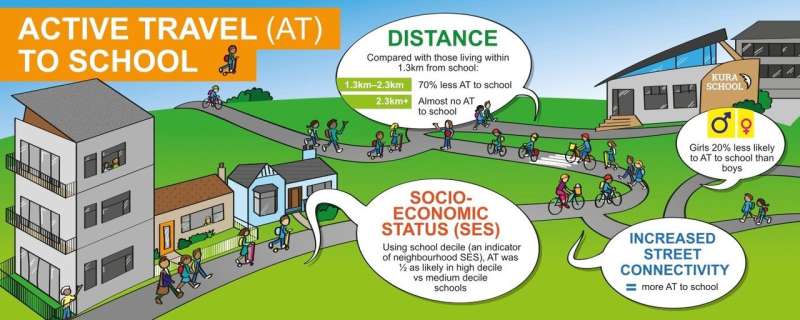New Zealand's secret recipe for active school travel: The neighborhood built environment

Increased rates of active travel (e.g., walking or cycling) to school in New Zealand children and youth were associated with shorter distances to school, and neighborhoods with more connected streets, less residential density, and lower socio-economic status, reveals a new systematic meta-analysis published in Journal of Transport and Health.
Urban form changes over recent decades in New Zealand reflect car-oriented, low density neighborhoods and greater sprawl. Obesity is a public health problem estimated to cost the country NZ$849 million a year. New Zealand has one of the highest rates of child obesity, and the lowest rates of active travel to school internationally. With evidence clearly showing tracking of obesity and activity behaviors from childhood to later life, tackling these issues early is imperative. Understanding the reasons for the low, and declining prevalence of active travel to school has become a priority for governments, urban planners, public health practitioners, and school and community groups.
This review provides in-depth understanding of how self-reported active travel modes were associated with objectively measured neighborhood built environment features (e.g., density of residence and intersections, distance to school) using geographic information systems (GIS). The meta-analysis included five studies across four major cities in New Zealand involving 2,844 children and youth aged 6-19 years.
"Meta-analysis is regarded as problematic to perform in the area of the built environment due to measurement inconsistency between individual studies. However, our review was accomplished by collaborating with several researchers across the country," said Erika Ikeda, MHSc and doctoral student, at Auckland University of Technology, Auckland, New Zealand. "Our experience has demonstrated the importance and value of undertaking a process such as this despite the challenges, particularly for generating robust, context-specific information.
"Our findings can substantially contribute to the development of policy and programs as well as the improvement of walking and cycling infrastructure. For example, planning decisions for school locations and school zoning/catchment policies should consider the impact of distance to school. Creating walking and cycle paths, trails and greenways improves street connectivity in school neighborhoods," Ms. Ikeda concluded.
This project is part of a larger investigation to identify "the secret recipe for active school travel," funded by the Ministry for Business Innovation and Employment. Research leader Associate Professor Melody Smith stated: "This world-first project is a fundamental first step in generating a context-specific understanding of the complexities of supporting active travel modes to school. Sensitivity and specificity are so important when we consider relationships between the built environment and health. That's what makes us so excited about this—when we combine these findings with insights from natural experiments and stakeholder interviews, we will have a truly comprehensive and context-specific model for school travel that can be used to inform urban planning practice, and ultimately improve physical activity and child health."
More information: Erika Ikeda et al, Built environment associates of active school travel in New Zealand children and youth: A systematic meta-analysis using individual participant data, Journal of Transport & Health (2018). DOI: 10.1016/j.jth.2018.04.007

















